engine Citroen DS4 2016 1.G Owner's Manual
[x] Cancel search | Manufacturer: CITROEN, Model Year: 2016, Model line: DS4, Model: Citroen DS4 2016 1.GPages: 436, PDF Size: 10.28 MB
Page 6 of 436
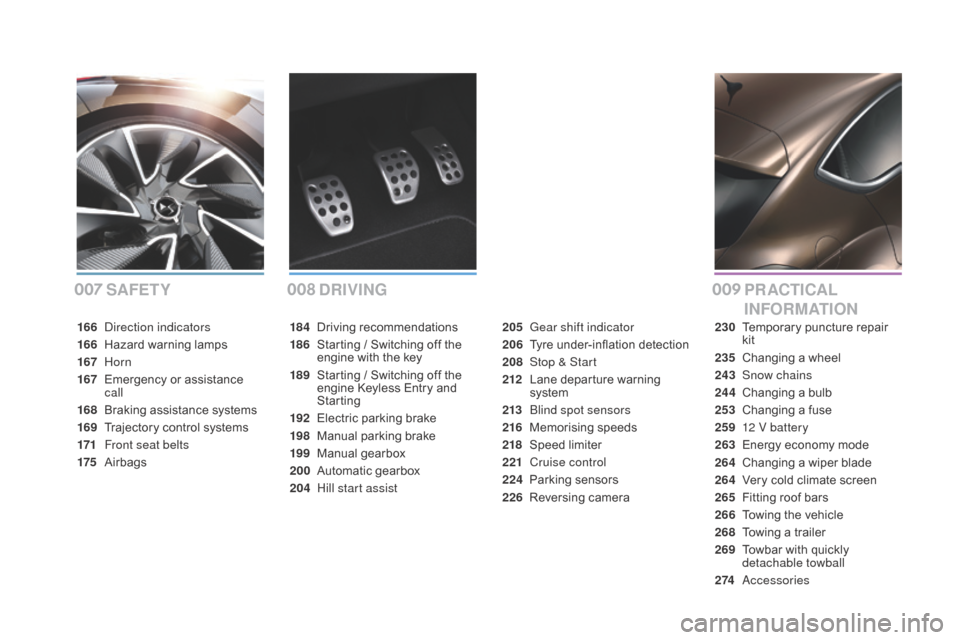
DS4_en_Chap00a_sommaire_ed03-2015
SAFETYdRIVING PR ACTICAL
INFORMATION
184 Driving recommendations
186
S
tarting / Switching off the
engine with the key
189
S
tarting / Switching off the
engine Keyless Entry and
Starting
192
E
lectric parking brake
198
M
anual parking brake
199
M
anual gearbox
200
A
utomatic gearbox
204
H
ill start assist
166 D
irection indicators
166
H
azard warning lamps
167
Horn
167
E
mergency or assistance
call
168
B
raking assistance systems
169
T
rajectory control systems
171
F
ront seat belts
175
A
irbags 230 T
emporary puncture repair
kit
235
C
hanging a wheel
243
S
now chains
244
C
hanging a bulb
253
C
hanging a fuse
259
1
2 V battery
263
E
nergy economy mode
264
C
hanging a wiper blade
264
V
ery cold climate screen
265
F
itting roof bars
266
T
owing the vehicle
268
T
owing a trailer
269
T
owbar with quickly
detachable towball
2 74
Accessories
008009
007
205 Gear shift indicator
206
T
yre under-inflation detection
208
St
op & Start
212
L
ane departure warning
system
213
B
lind spot sensors
216
M
emorising speeds
218
Spe
ed limiter
221
C
ruise control
224
P
arking sensors
226
R
eversing camera
Page 7 of 436
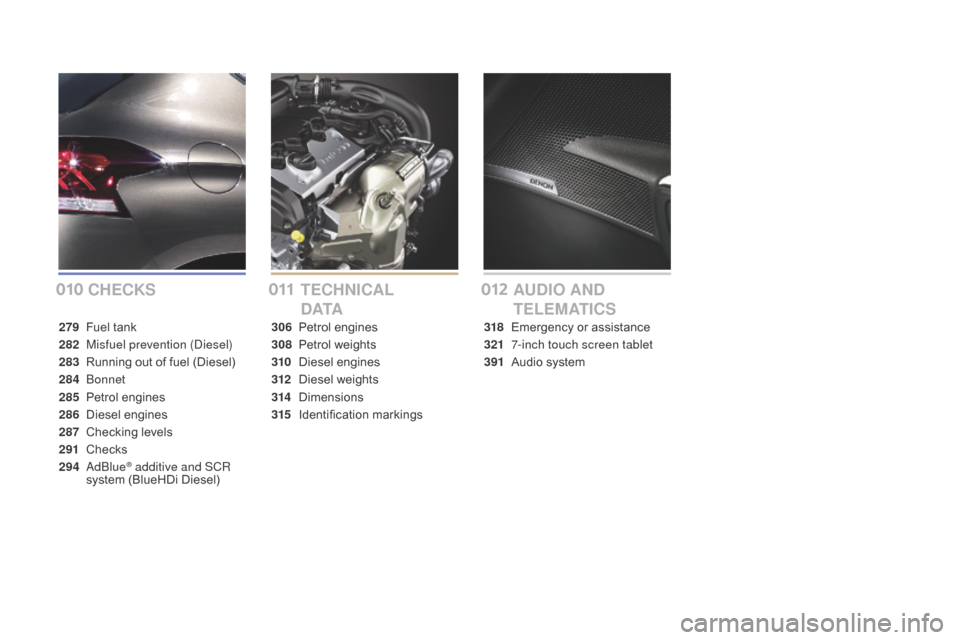
DS4_en_Chap00a_sommaire_ed03-2015
CHECKSTECHNICAL
dAT
AAUdI
O ANd
T ELEMATICS
279 Fuel tank
282
M
isfuel prevention (Diesel)
283
R
unning out of fuel (Diesel)
284
Bonnet
285
Pe
trol engines
286
D
iesel engines
287
C
hecking levels
291
C
hecks
294
AdBlue
® additive and SCR
system (BlueHDi Diesel) 306
Pe
trol engines
308
Pe
trol weights
310
D
iesel engines
312
D
iesel weights
314
D
imensions
315
I
dentification markings
012
010 011
318 Emergency or assistance
321
7
-inch touch screen tablet
391
A
udio system
Page 15 of 436
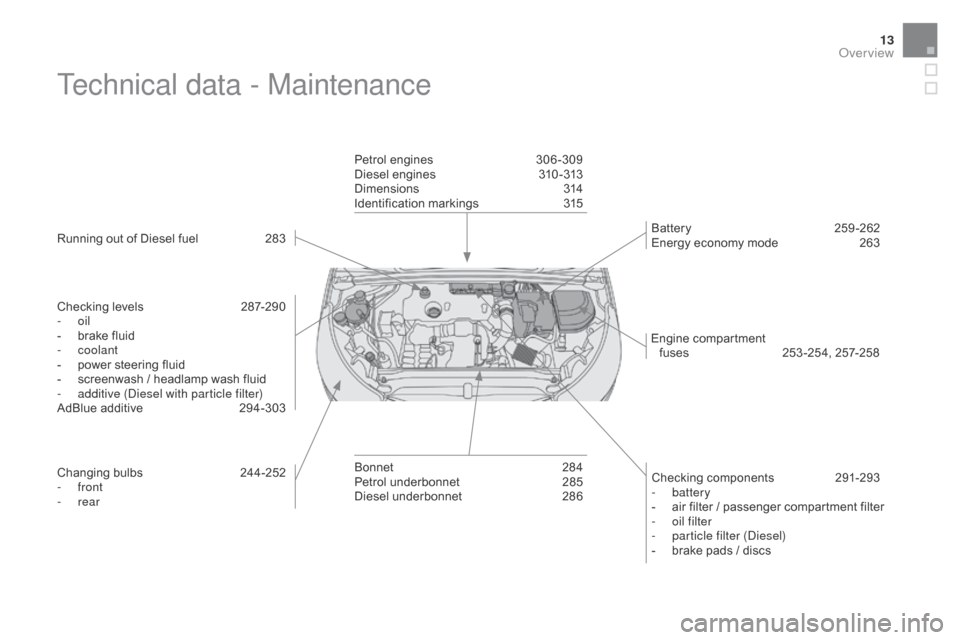
13
DS4_en_Chap00b_vue-ensemble_ed03-2015
Technical data - Maintenance
Running out of Diesel fuel 283
Checking levels
2
87-290
-
oil
-
b
rake fluid
-
coolant
-
p
ower steering fluid
-
s
creenwash / headlamp wash fluid
-
a
dditive (Diesel with particle filter)
AdBlue additive
2
94-303
Changing bulbs
2
44-252
-
front
-
rear Petrol engines
3
06 -309
Diesel engines
3
10 -313
Dimensions
3
14
Identification markings
3
15
Bonnet
2
84
Petrol underbonnet
2
85
Diesel underbonnet
2
86Checking components
2
91-293
-
battery
-
a
ir filter / passenger compartment filter
-
o
il filter
-
p
article filter (Diesel)
-
b
rake pads / discs
Battery 2
59-262
Energy economy mode 2 63
Engine compartment
fuses
25
3-254, 257-258
Over view
Page 16 of 436
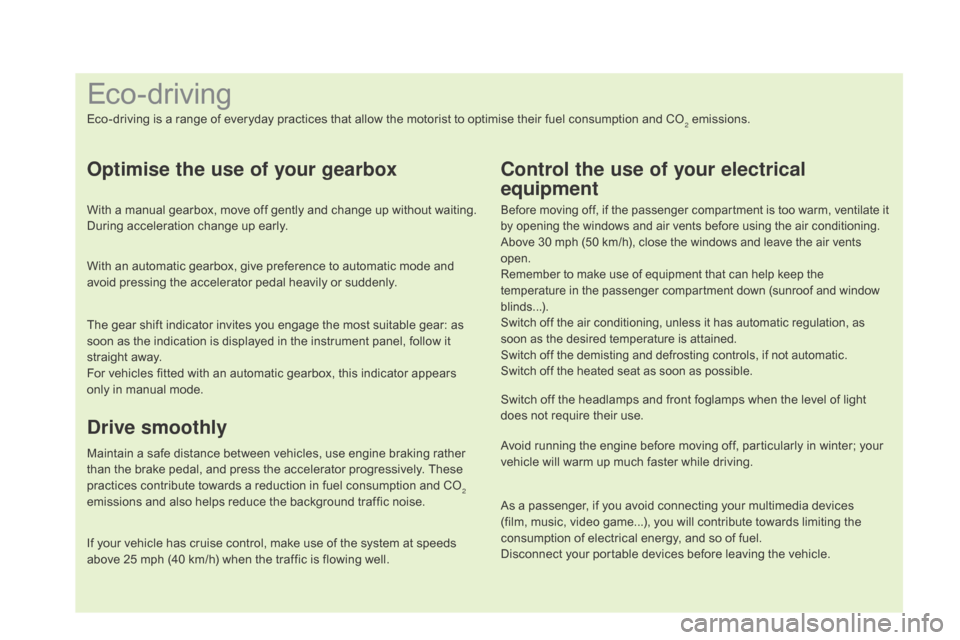
As a passenger, if you avoid connecting your multimedia devices
(film, music, video game...), you will contribute towards limiting the
consumption of electrical energy, and so of fuel.
Disconnect your portable devices before leaving the vehicle.
Eco-driving
Eco-driving is a range of everyday practices that allow the motorist to optimise their fuel consumption and CO2 emissions.
Optimise the use of your gearbox
With a manual gearbox, move off gently and change up without waiting.
During acceleration change up early.
With an automatic gearbox, give preference to automatic mode and
avoid pressing the accelerator pedal heavily or suddenly.
The gear shift indicator invites you engage the most suitable gear: as
soon as the indication is displayed in the instrument panel, follow it
straight away.
For vehicles fitted with an automatic gearbox, this indicator appears
only in manual mode.
drive smoothly
Maintain a safe distance between vehicles, use engine braking rather
than the brake pedal, and press the accelerator progressively. These
practices contribute towards a reduction in fuel consumption and CO
2
emissions and also helps reduce the background traffic noise.
If your vehicle has cruise control, make use of the system at speeds
above 25 mph (40 km/h) when the traffic is flowing well.
Control the use of your electrical
equipment
Before moving off, if the passenger compartment is too warm, ventilate it
by opening the windows and air vents before using the air conditioning.
Above 30 mph (50 km/h), close the windows and leave the air vents
open.
Remember to make use of equipment that can help keep the
temperature in the passenger compartment down (sunroof and window
blinds...).
Switch off the air conditioning, unless it has automatic regulation, as
soon as the desired temperature is attained.
Switch off the demisting and defrosting controls, if not automatic.
Switch off the heated seat as soon as possible.
Switch off the headlamps and front foglamps when the level of light
does not require their use.
Avoid running the engine before moving off, particularly in winter; your
vehicle will warm up much faster while driving.
Page 17 of 436
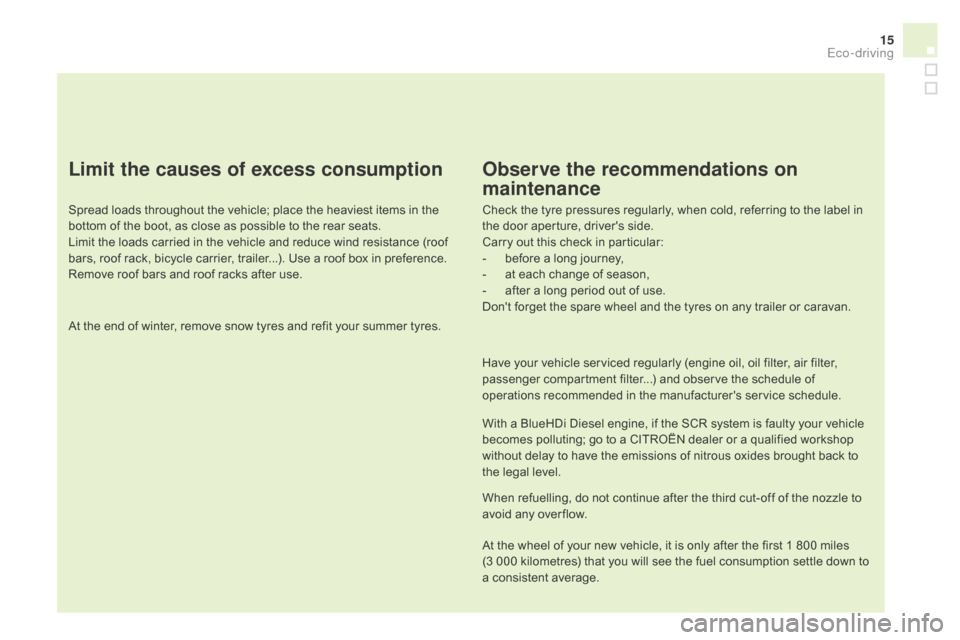
15
DS4_en_Chap00c_eco-conduite_ed03-2015
Limit the causes of excess consumption
Spread loads throughout the vehicle; place the heaviest items in the
bottom of the boot, as close as possible to the rear seats.
Limit the loads carried in the vehicle and reduce wind resistance (roof
bars, roof rack, bicycle carrier, trailer...). Use a roof box in preference.
Remove roof bars and roof racks after use.
At the end of winter, remove snow tyres and refit your summer tyres.
Observe the recommendations on
maintenance
Check the tyre pressures regularly, when cold, referring to the label in
the door aperture, driver's side.
Carry out this check in particular:
-
b
efore a long journey,
-
a
t each change of season,
-
a
fter a long period out of use.
Don't forget the spare wheel and the tyres on any trailer or caravan.
Have your vehicle serviced regularly (engine oil, oil filter, air filter,
passenger compartment filter...) and observe the schedule of
operations recommended in the manufacturer's service schedule.
With a BlueHDi Diesel engine, if the SCR system is faulty your vehicle
becomes polluting; go to a CITROËN dealer or a qualified workshop
without delay to have the emissions of nitrous oxides brought back to
the legal level.
When refuelling, do not continue after the third cut-off of the nozzle to
avoid any over flow.
At the wheel of your new vehicle, it is only after the first 1 800 miles
(3
000 kilometres) that you will see the fuel consumption settle down to
a consistent average.
Eco-driving
Page 22 of 436
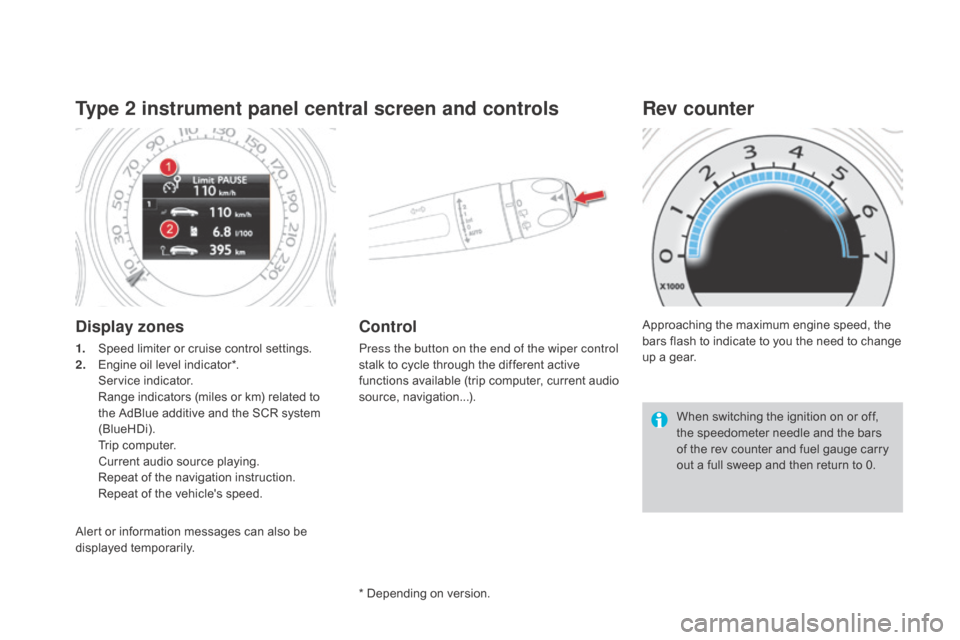
DS4_en_Chap01_controle-de-marche_ed03-2015
Type 2 instrument panel central screen and controls
display zones
1. Speed limiter or cruise control settings.
2. Engine oil level indicator*.
S
ervice indicator.
R
ange indicators (miles or km) related to
the AdBlue additive and the SCR system
(BlueHDi).
T
rip computer.
C
urrent audio source playing.
R
epeat of the navigation instruction.
R
epeat of the vehicle's speed.
Control
Press the button on the end of the wiper control
stalk to cycle through the different active
functions available (trip computer, current audio
source, navigation...). Approaching the maximum engine speed, the
bars flash to indicate to you the need to change
up a gear.
Rev counter
When switching the ignition on or off,
the speedometer needle and the bars
of the rev counter and fuel gauge carry
out a full sweep and then return to 0.
* Depending on version.
Alert or information messages can also be
displayed temporarily.
Page 23 of 436

21
DS4_en_Chap01_controle-de-marche_ed03-2015
Visual indicators which inform the driver of the
occurrence of a malfunction (warning lamp)
or of the operation of a system (operation or
deactivation indicator lamp).
Warning and indicator lamps
When the ignition is switched on
Certain warning lamps come on for a
few seconds when the ignition is switched on.
When the engine is started, these warning
lamps should go off.
If they remain on, before moving off, refer to the
information on the warning lamp in question.
Associated warnings
The illumination, fixed or flashing, of certain
warning lamps may be accompanied by
an audible signal and a message in the
multifunction screen or in the type 2 instrument
panel central screen.
Monitoring
Page 24 of 436
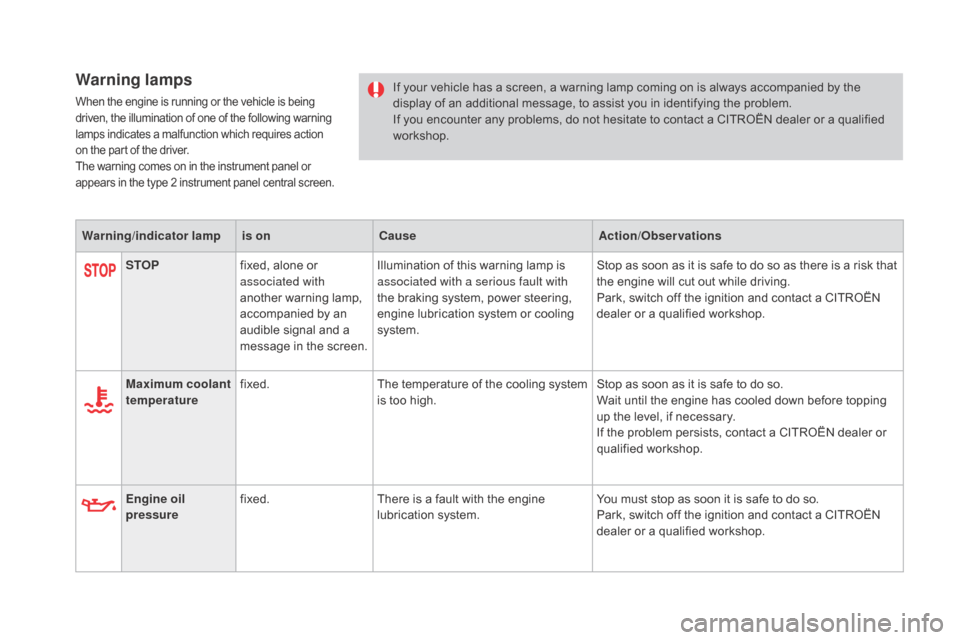
DS4_en_Chap01_controle-de-marche_ed03-2015
Warning lamps
When the engine is running or the vehicle is being
driven, the illumination of one of the following warning
lamps indicates a malfunction which requires action
on the part of the driver.
The warning comes on in the instrument panel or
appears in the type 2 instrument panel central screen.If your vehicle has a screen, a warning lamp coming on is always accompanied by the
display of an additional message, to assist you in identifying the problem.
If you encounter any problems, do not hesitate to contact a CITROËN dealer or a qualified
workshop.
Warning /indicator lampis on Cause Action/Observations
STOP fixed, alone or
associated with
another warning lamp,
accompanied by an
audible signal and a
message in the screen. Illumination of this warning lamp is
associated with a serious fault with
the braking system, power steering,
engine lubrication system or cooling
system.
Stop as soon as it is safe to do so as there is a risk that
the engine will cut out while driving.
Park, switch off the ignition and contact a CITROËN
dealer or a qualified workshop.
Maximum coolant
temperature fixed.
The temperature of the cooling system
is too high. Stop as soon as it is safe to do so.
Wait until the engine has cooled down before topping
up the level, if necessary.
If the problem persists, contact a CITROËN dealer or
qualified workshop.
Engine oil
pressure fixed.
There is a fault with the engine
lubrication system. You must stop as soon it is safe to do so.
Park, switch off the ignition and contact a CITROËN
dealer or a qualified workshop.
Page 25 of 436
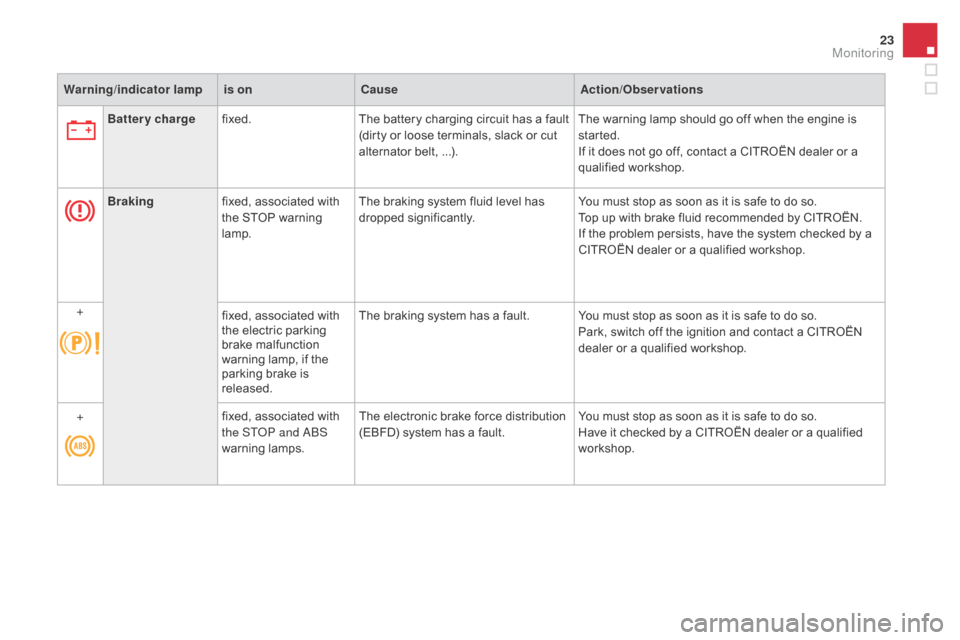
23
DS4_en_Chap01_controle-de-marche_ed03-2015
Warning/indicator lampis on Cause Action/Observations
Battery charge fixed. The battery charging circuit has a fault
(dirty or loose terminals, slack or cut
alternator belt, ...). The warning lamp should go off when the engine is
started.
If it does not go off, contact a CITROËN dealer or a
qualified workshop.
Braking fixed, associated with
the STOP warning
lamp. The braking system fluid level has
dropped significantly.
You must stop as soon as it is safe to do so.
Top up with brake fluid recommended by CITROËN.
If the problem persists, have the system checked by a
CITROËN dealer or a qualified workshop.
+ fixed, associated with
the electric parking
brake malfunction
warning lamp, if the
parking brake is
released.The braking system has a fault. You must stop as soon as it is safe to do so.
Park, switch off the ignition and contact a CITROËN
dealer or a qualified workshop.
+ fixed, associated with
the STOP and ABS
warning lamps.The electronic brake force distribution
(EBFD) system has a fault.
You must stop as soon as it is safe to do so.
Have it checked by a CITROËN dealer or a qualified
workshop.
Monitoring
Page 28 of 436
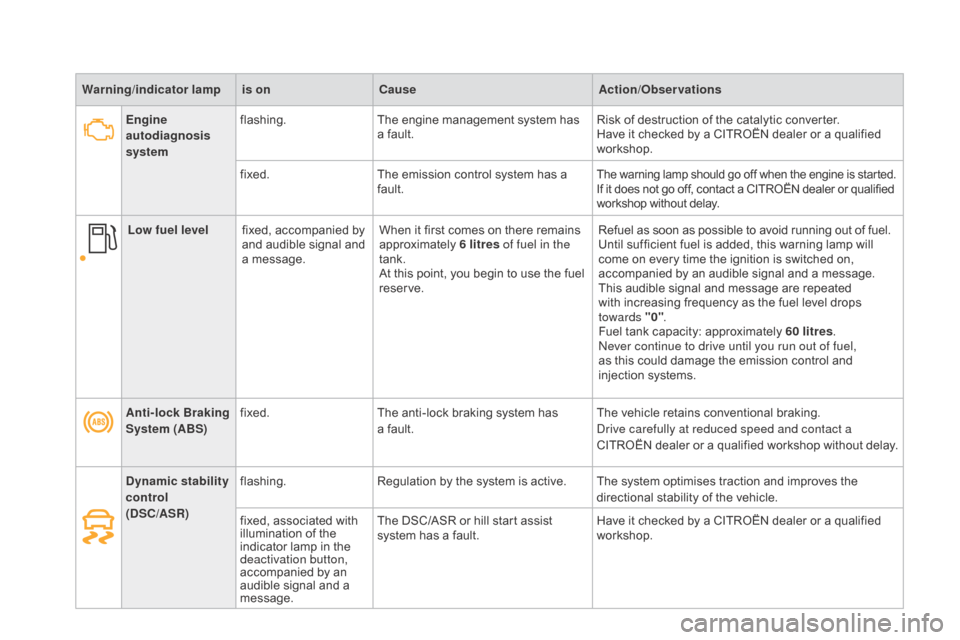
DS4_en_Chap01_controle-de-marche_ed03-2015
Warning/indicator lampis on Cause Action/Observations
Anti-lock Braking
System (ABS) fixed.
The anti-lock braking system has
a fault. The vehicle retains conventional braking.
Drive carefully at reduced speed and contact a
CITROËN dealer or a qualified workshop without delay.
dy
namic stability
control
(
dS
C/ASR) flashing.
Regulation by the system is active. The system optimises traction and improves the
directional stability of the vehicle.
fixed, associated with
illumination of the
indicator lamp in the
deactivation button,
accompanied by an
audible signal and a
message. The DSC/ASR or hill start assist
system has a fault.
Have it checked by a CITROËN dealer or a qualified
workshop.
Engine
autodiagnosis
system
flashing.
The engine management system has
a fault. Risk of destruction of the catalytic converter.
Have it checked by a CITROËN dealer or a qualified
workshop.
fixed. The emission control system has a
fault.
The warning lamp should go off when the engine is started.If it does not go off, contact a CITROËN dealer or qualified
workshop without delay.
Low fuel level fixed, accompanied by
and audible signal and
a message. When it first comes on there remains
approximately
6 litres of fuel in the
tank.
At this point, you begin to use the fuel
reserve. Refuel as soon as possible to avoid running out of fuel.
Until sufficient fuel is added, this warning lamp will
come on every time the ignition is switched on,
accompanied by an audible signal and a message.
This audible signal and message are repeated
with increasing frequency as the fuel level drops
towards
"0".
Fuel tank capacity: approximately 60 litres .
Never continue to drive until you run out of fuel,
as this could damage the emission control and
injection systems.